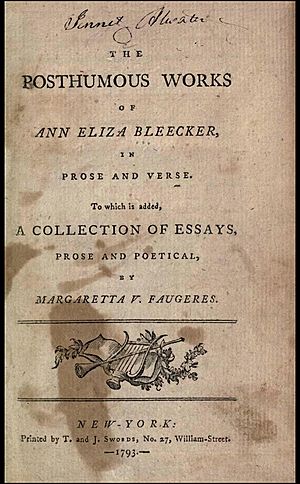Margaretta Faugères facts for kids
Quick facts for kids
Margaretta Faugères
|
|
|---|---|
 |
|
| Born | Margaretta V. Bleecker October 11, 1771 New York City |
| Died | January 9, 1801 (aged 29) Brooklyn |
| Occupation | Author and political activist |
Margaretta Faugères (born October 11, 1771, died January 9, 1801) was an American writer and activist. She was the daughter of another famous writer, Ann Eliza Bleecker. Margaretta wrote plays and poems. She also spoke out about important political issues. After the American Revolutionary War, she became well-known in New York City. She was seen as a very talented and smart woman.
Margaretta faced many challenges in her life. Her marriage was difficult, and she lost her husband in 1798. Later, she taught at a school for girls in New Brunswick. She passed away at the young age of 29.
Contents
Early Life and Education
Margaretta V. Bleecker was born in New York City. Her parents were John and Ann Eliza Bleecker. They were part of a wealthy Dutch-American family. Soon after she was born, her family moved to their country home. This home was in Tomhannock, a small village near Albany.
They lived peacefully until the American Revolution began. Margaretta's mother, Ann Eliza Bleecker, was a writer. She encouraged Margaretta to write too. During the war, Margaretta lost her grandmother, aunt, and sister. Her mother was very sad and never fully recovered.
Margaretta described their life after the war as "tolerable tranquility." Her mother struggled with sadness. She even destroyed most of her own writings. Margaretta faced more tragedy when her mother died when she was just twelve years old.
After her mother's death, Margaretta and her father moved back to New York City. There, she continued her education. She also began to write more of her own works.
Writing Career and Activism
Margaretta Faugères worked hard to make sure her mother's writings were known. She also wanted to establish her own reputation as a writer. In 1790, she started publishing her mother's poems. These were published in The New York Magazine.
She also began publishing her own essays and poems in the same magazine. Her reputation as a poet grew quickly. For a few years, she was considered the magazine's "premier poet." Margaretta had strong political beliefs. She focused her writing on important causes.
Speaking Out Against Slavery
Margaretta was a strong supporter of the anti-slavery movement. In June 1791, The New York Magazine published her essay. It was called Fine Feelings Exemplified in the Conduct of a Negro Slave. In this essay, she disagreed with Thomas Jefferson's idea. He had claimed that enslaved people lacked "finer feelings."
Margaretta wrote that she believed their feelings were just as strong. She said this was true even if their skin color was different. She explained that facts supported her view. She felt it was important to challenge such ideas.
Supporting the French Revolution
Margaretta also supported the French Revolution. Her friendship with a French doctor, Peter Faugeres, likely influenced her views. He shared her political ideas. They got married on Bastille Day, July 14, 1792. This was against her father's wishes.
Sadly, her marriage was not happy. Within a few years, her husband spent all of her large fortune. In 1793, she published an important book. It was called The Posthumous Works of Ann Eliza Bleecker in Prose and Verse, to which is added a Collection of Essays, Prose and Poetical. This book included her mother's work and her own.
In 1795, Margaretta wrote a play called Belisarius: A Tragedy. This was a major literary achievement for her. It was a play in four acts. It showed her strong beliefs about human rights.
Views on Justice and Punishment
Faugères was against the death penalty for murder. This view was more radical than most people's at the time. She felt it was wrong for a country that valued freedom and happiness. In 1797, she wrote a pamphlet called The Ghost of John Young.
This six-page poetic story argued against using capital punishment. She wrote from the perspective of a character named John Young. He spoke from the grave about his experience.
Later Life and Legacy
Not much is known about the rest of Margaretta's life. Her husband died in 1798. She then taught at a school in New Brunswick, New Jersey. Later, she taught in Brooklyn. Her last published work was an "Ode." It was written to support a speech given by Governor George Clinton on July 4, 1798. She had long supported Governor Clinton.
The "Ode" reminded people about the cost of the revolution. It also spoke about the need for change. Margaretta Faugères looked beyond her own privileged background. She wrote about important ideas like equality and justice. She wanted to see big changes in American society and politics.
Family Life
Margaretta Van Wyck Bleecker and Peter Faugeres had two daughters. Their names were Eveanna Electa Faugeres (1795–1841) and Margaret Mason Faugeres (1797–1820). Eveanna married John Anthony Bleecker and had eight children. Margaret married Edward P. Brady. She was married for five years before she passed away.
Margaretta Faugères died on January 9, 1801, in Brooklyn. She is buried next to her father. Her grave is in the Bowery Methodist Church cemetery.
Images for kids


